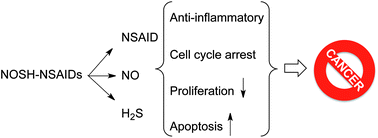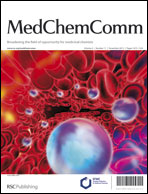Synthesis and biological activity of NOSH-naproxen (AVT-219) and NOSH-sulindac (AVT-18A) as potent anti-inflammatory agents with chemotherapeutic potential†
Abstract
Nitric oxide- (NO) and hydrogen sulfide- (H2S) releasing naproxen (NOSH-naproxen) and NO and H2S-releasing sulindac (NOSH-sulindac) were synthesized and their cell growth inhibitory properties were evaluated in four different human cancer cell lines. These cell lines are of adenomatous (colon, pancreas), epithelial (breast), and lymphocytic (leukemia) origin. Using HT-29 human colon cancer cells, NOSH-naproxen and NOSH-sulindac increased apoptosis, and inhibited proliferation. NOSH-naproxen caused a G0/G1 block whereas NOSH-sulindac caused a G2/M block in the cell cycle. Both compounds exhibited significant anti-inflammatory properties, using the carrageenan rat paw edema model. Reconstitution and structure–activity studies representing a fairly close approximation to the intact molecule showed that NOSH-naproxen was approximately 8000-fold more potent than the sum of its parts in inhibiting cell growth. Our data suggest that these compounds merit further investigation as potential anti-cancer agents.


 Please wait while we load your content...
Please wait while we load your content...